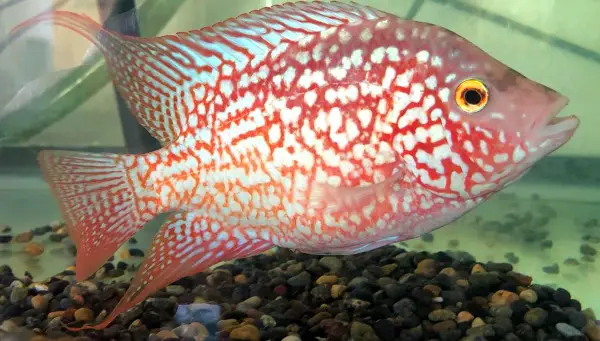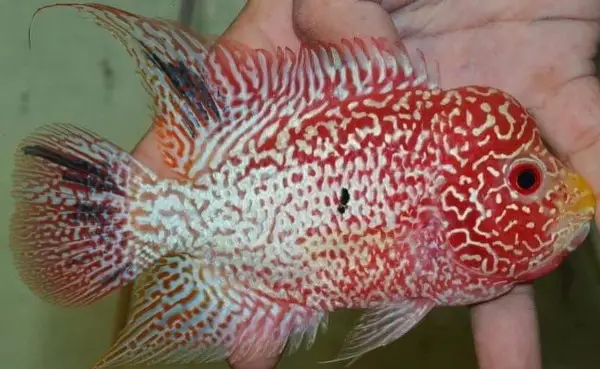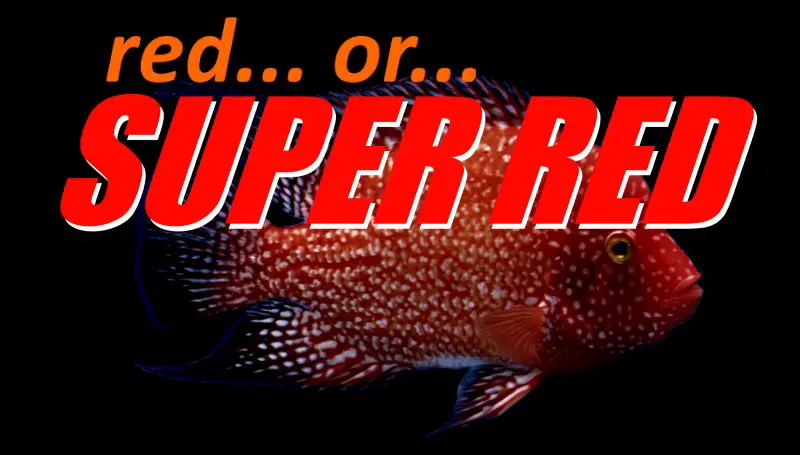Let’s talk about the difference between red and super red Texas cichlids, because for the newcomer it can seem confusing!
Obtaining red coloration via selecting breeding (or hybridizing in this case) has always been a bit of a unicorn in the fishkeeping hobby. Red in goldfish is challenging to obtain and sustain, and if you look at so-called “super red” bristlenose plecos you’ll see that they aren’t really red at all. Same goes for severums, their “super red” strain is closer, but still not perfect.
What’s That Got To Do With Red Texas Cichlids?
So, that brings me to red Texas cichlids. Sometimes you’ll see people referring to a fish as a “super” red Texas cichlid, rather than just a plain old red Texas.

So, in this article I want to discus (the very simple) difference between a red Texas and a super red Texas cichlid.
So, What Is The Difference Between “Red” And “Super Red”?
Not much, in all honesty. The difference between a red Texas and a super red Texas is simply how red the fish looks. Red Texas are a more orange looking fish. While, a crimson, scarlet, or cherry red fish is known as a super red Texas.
Are Super Red Texas Bred Differently?
Actually, no.
With red Texas cichlids we have to remember that the name refers to both the composition of the fish and the aesthetic of the fish.
To be a red Texas cichlid, it must have:
- Texas cichlid blood. While any fish from the herichthys genus is fine, H. cyanoguttatus is typical).
- Somewhat red coloration. Blood parrots and red mammons are common choices for providing red coloration. In turn, their red is derived from amphilophus blood.
So, whether a fish qualifies as a super red Texas or a standard red Texas cichlid really has little to do with the component species used to create the hybrid.
Check out my article on how to breed red Texas cichlids to find out more about how they’re created.
So Is It Just Luck If You Get Super Red?
Yes, and no. But, for the time being, we’ll answer the yes part.
Red Texas cichlids are hybrids. Therefore, when you breed a green Texas with a blood parrot (i.e. how you create red Texas) their offspring are—for want of a better term—a real hodge podge. Most of them will be very ugly, most of them will lack pearls, and in the long run, many will not fade.
Fading is the process by which a dark fish “fades” to a preferred red or orange color.

So, the challenge for red Texas breeders is to find the very small number of red Texas offspring that display pearls early in life, separate them, grow them on, and wait to see if they fade.
The breeder finds out the quality of the red in the fish when it fades. Because, it could fade to yellow, orange, or red—and every color in between! Also, bear in mind, there’s no guarantee a fish will ever fade.
What About The Part Of It That Isn’t Luck?
Well, a big chunk of it isn’t luck, to be honest. If you do have a red Texas cichlid that has faded, but hasn’t really got a nice red color that you could call “super” red, then there is something you can do about it.
Diet!
Red Texas cichlids pick up red pigmentation from their food. So, if you feed a food aimed at enhancing that red coloration then you can improve it.
Everybody Has A Food They Prefer
There are a lot of foods out there that will enhance red in your fish, and, lots of them are very good. For example, Excalibur’s red enhancing pellets are extremely popular with red Texas breeders and keepers alike.

However, I’m an old school Hikari fan, and they make their own red enhancing food aimed at blood parrots and red mammons that works just as well for red Texas cichlidis. Conveniently, it’s available via Amazon and you can grab it here (affiliate link).
What Makes A Good Red Texas Cichlid?
I’ve got an article discussing some of the preferred traits in red Texas cichlids. Check it out here.


